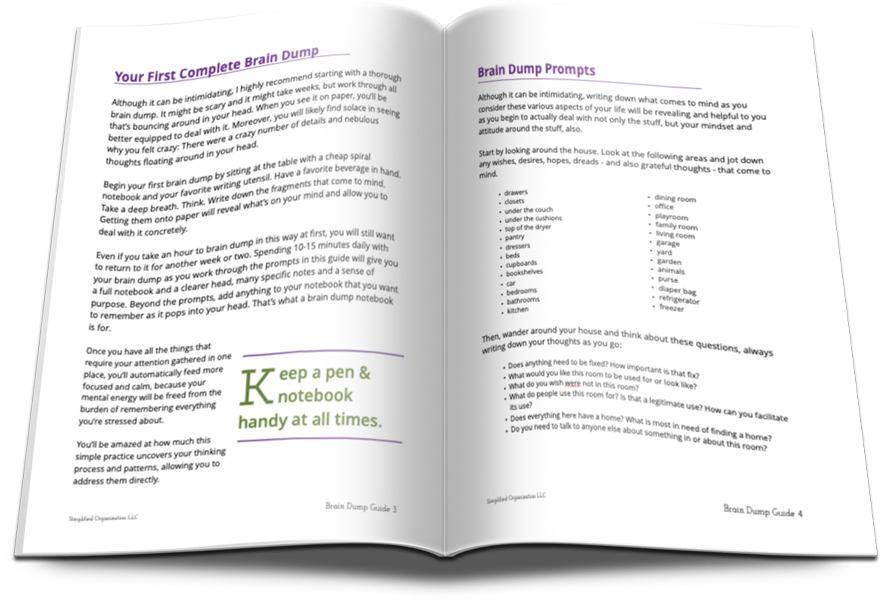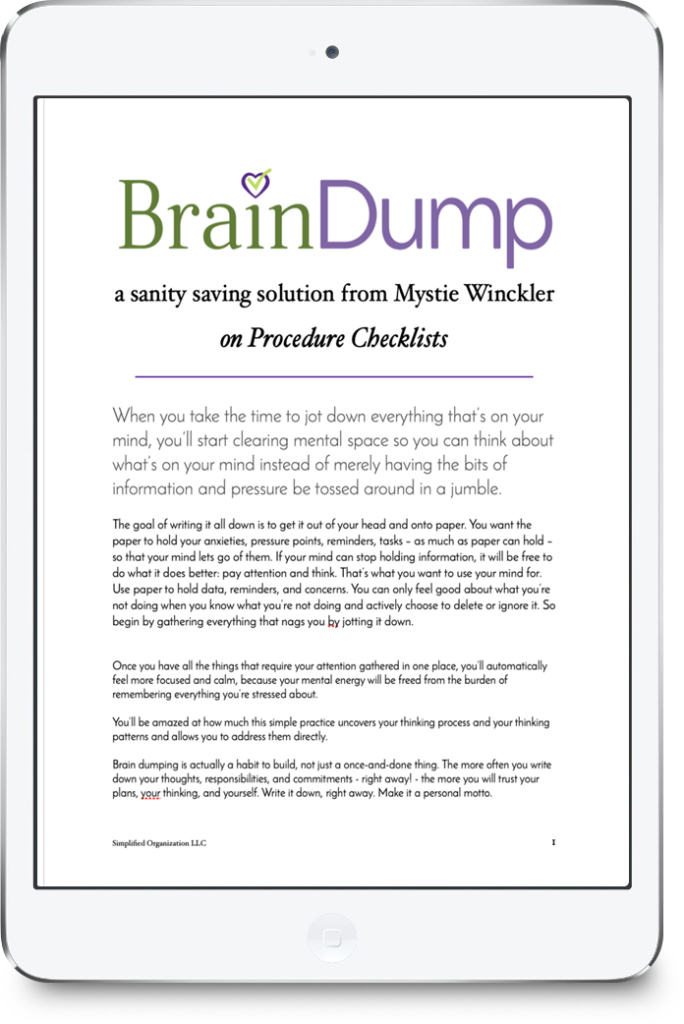We all know the feeling, and it’s bound to happen whenever you want to organize your life.
Your head is spinning; your mind is in overdrive. You try to multitask, putting out a fire here and remembering something else halfway though.
We jump from one task to the next, not always finishing one before starting another.
You might call the feeling overwhelm or craziness or even panic.
I have a solution: a brain dump.
It’s simple, but surprisingly successful at calming internal chatter and chaos.
Whether you’ve never tried this practice or if you’re currently on your fifth brain dump notebook, sitting down to brain dump is a practice that is worth the time.
Over the years I’ve learned some things from practicing it myself and I’ve also received many questions about it, so this post should give you all you need to answer your questions and overcome your resistance.
How to get started with a brain dump.
I’ve written a number of times about brain dumps, much of it being within the courses Simplified Organization: Learn to Love What Must Be Done and also Work the Plan. After all, the best way to begin a project – especially a life-overhaul project – is with a brain dump.
Dump all those swirling thoughts out of your head.
Yes, simply writing it all down will help to
- Reduce stress by getting your thoughts onto paper
- Reduce frustration by assigning homes to stuff, tangible & intangible
- Reduce anxiety by knowing what you have on your plate

Declutter your head.
Pause to declutter your mind before setting up an organization system.
Too often we jump right into planners and calendars and to do lists when we want to get organized, thinking the right tool will solve our problem. But tools work on material – if the material is not at hand and known, how do you know what tool you need?
With a brain dump you can discover what material you’re working on and what goals you’re pushing toward.
So before you start crafting a new organization system for the new year, pull out a cheap spiral notebook and list out what didn’t work about the last attempt, what did work, what projects you have going on, what hopes and goals and responsibilities you currently have, what’s bothering you, what’s motivating you to try again with a new planner, what you want in a planner, when you’ll use it, how you’ll use it. Just start writing and let the ideas flow.
The goal is always to empty your head – not in a weird meditation way, but simply to have a mind emptied of details and unburdened from the responsibility of remembering and reminding so that your mind has enough space and freedom and calm to actually think creatively and problem solve.
Our goal with any and all mind decluttering sessions is to switch from using our brains as storage devices (which they aren’t good at anyway) to using them for creative solution generation (which they are good at).
All the information that you end up generating might not be useful – much of it probably will not be. But switching your mind’s mode from detail-reminder to creative thinking will be useful.
What’s the right format?
There is no right or wrong way to do a brain dump, except for holding things back from the paper and trying to keep them stored in your mind.
It’s true that writing out by hand acts differently from typing with the brain. There’s a stronger memory bond in our minds when we write out by hand rather than type. However, the goal of a brain dump is to get information out of our heads, not into our heads. So the method should simply be the most comfortable for you.
Some like to draw or mind-map as they write, so paper works better.
Some type much faster than they write by hand, so digital works better.
Some start with verbal brain dumping using a speech-to-text or voice memo app so they can spill their mind out through their mouth. That’s a great option, too.
When it comes to decluttering your mind, choose the method that is fastest, most convenient, and most attractive to you.
First declutter your mind, then set up, then process.
It’s important to know the phases of information processing and information management before you begin, otherwise you’ll likely freeze up mid-brain dump when the amount of words spilling forth scares you.
Generating all this information is scary, because we start thinking of each thing as a commitment or as a thing to do. So we reign it in, in order to minimize the amount of perceived work to do.
The problem is, all this information, all these vague obligations and responsibilities, are in your heart and head already. A brain dump is simply acknowledging them and actually seeing them all together.
Processing comes after as much as possible has been spilled onto paper. Don’t stop to process, to organize, to commit. Keep going until there’s nothing more that hasn’t already been written down.
When you see everything, you’re going to make better decisions, prioritize better, and understand better why you’re so anxious.
Once the brain dump is complete – for now, anyway – the next step will be to set up your planning system. Before you can cull and organize and make things actionable, you have to have your tools: your calendar, task management system, and reference system.
Then, once you have all the information and all the places it will go (add a trash can to that list of tools you’ll need), you can start organizing. The first step when you begin processing your brain dump list will be to delete as much as possible.
It might seem counterintuitive to spend all that time generating ideas and information only to delete a good chunk of it, but it isn’t. Just as in decluttering a closet, to declutter your mind you must first empty it, even if half the contents is bound for the trash.
In fact, this is the step that will give you the most calm and peace. Instead of having the ideas rattling around in your head and shoving them back every now and again, you’re consciously choosing to remove them from your radar. When you see all you have going on in your life, you’re better able to make decisions and cutting the unnecessary and removing the vague obligations that have no place in your life right now. With a decluttered mind, your perspective can shift to the big picture.
When you declutter your mind, the amount in there will astonish you.
I recently received a brain-dump related plea for clarification and help:
Help! When I start writing down things that have been buried for months in my head and my closets, I immediately start thinking of more ideas and more things to write down! Will brain dumping ever end?
The answer is both yes and no.
The continual generation is part of the point. We don’t even realize all that we have lurking on our mental and emotional radars until we start putting pen to paper. Fill a whole spiral notebook! Then you will understand why you feel like life is crazy and out of control.
It will eventually slow down and maybe even stop. But especially for moms managing a bustling household, the process can take weeks. Partly it will take weeks because our time is always interrupted. Partly it will take weeks because as we uncover more and move about our regular routines, we’ll think of more and more and more.
Write it down.
On the other hand, just like decluttering closets, decluttering your mind is never really done. It’s a strategy to return to again and again, whenever you need to get a grip on a project, an event, or a head full of distractions and details.
Three levels to declutter your mind
In fact, there are three kinds or three levels of brain dumps.
First, there is the thorough, complete, gigantic brain dump that might take you a month or more. This is like a mind-purging event, and it is cathartic once it’s done. Trust me, and just keep spilling until there’s no more to spill, Keep jotting everything down without worrying about what you’ll do with all this stuff when you’re done.
Second, there is project-based brain dumping. Before you start a new project or plan a new year or host a large event, sit down with a pad of paper and brain dump everything you can about it: what you want it to be, why you want to do it, random details, big picture goals – as it occurs to you, just write it all down. Ideas will begin to coalesce and you’ll have an important reference to work from as you tackle your project.
Third, there is ubiquitous capture. After you’ve brain dumped and felt the mental release of details being on paper instead of rattling around in your head, you’ll not want to go back to using your mind as a reminder system. So, you need to learn the ubiquitous capture habit: Write it down, right away.
A procedure checklist is the jumpstart you need.
You can’t use anyone else’s plans. You have to figure out what you need for yourself in your own situation. This brain dump guide will walk you through the process of setting up your own simple, straightforward procedure checklists so that you can get more momentum in your day.



3 Comments